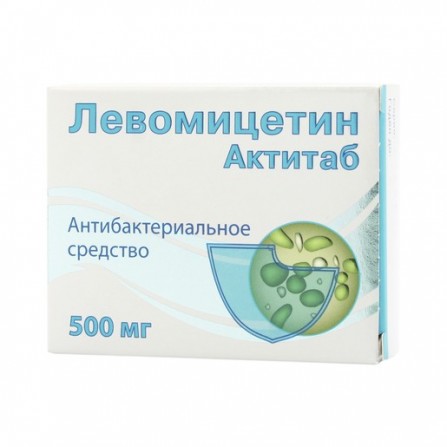Levomycetin Actitol pill 500 mg 10 pcs
Condition: New product
1000 Items
Rating:
Be the first to write a review!

More info
Active ingredients
Chloramphenicol
Release form
Pills
Composition
Active ingredient: Chloramphenicol (Chloramphenicolum) Active ingredient concentration (mg): 500
Pharmacological effect
Broad-spectrum antibiotic. The mechanism of antimicrobial action is associated with impaired protein synthesis of microorganisms. It has a bacteriostatic effect. Active against gram-positive bacteria: Staphylococcus spp., Streptococcus spp .; Gram-negative bacteria: Neisseria gonorrhoeae, Neisseria meningitidis, Escherichia coli, Haemophilus influenzae, Salmonella spp., Shigella spp., Klebsiella spp., Serratia spp., Yersinia spp., Proteus spp., Rickettsia spp. is also active against Spirochaetaceae, some large viruses. Chloramphenicol is active against strains resistant to penicillin, streptomycin, sulfonamides. The resistance of microorganisms to chloramphenicol develops relatively slowly.
Pharmacokinetics
After ingestion is rapidly and completely absorbed from the gastrointestinal tract. Bioavailability is 80%. Quickly distributed in the body. Plasma protein binding is 50-60%. Metabolized in the liver. T1 / 2 is 1.5-3.5 hours. Excreted in the urine, small amounts from feces and bile.
Indications
Urinary and biliary tract infections caused by susceptible microorganisms.
Contraindications
- hypersensitivity; - depression of bone marrow hematopoiesis; - acute intermittent porphyria; - deficiency of glucose-6-phosphate dehydrogenase; - hepatic and / or renal failure; - skin diseases (psoriasis, eczema, fungal lesions); - pregnancy; - lactation period; - children age up to 3 years and / or body weight less than 20 kg.
Precautionary measures
Do not exceed recommended doses.
Use during pregnancy and lactation
Chloramphenicol is contraindicated for use during pregnancy and lactation (breastfeeding).
Dosage and administration
Inside (30 minutes before a meal, and with the development of nausea and vomiting - 1 hour after a meal), 3-4 times / day. Single dose for adults - 0.25-0.5 g, daily - 2 g. In severe forms of infections (in the hospital), it is possible to increase the dose to 3-4 g / day (under the control of the blood, kidney and liver function). Children older than 3 years and / or weighing more than 20 kg should be prescribed at 12.5 mg / kg every 6 hours or 25 mg every 12 hours, for severe infections, up to 75-100 mg / kg / day (under control serum drug concentrations). The average duration of treatment is 8-10 days.
Side effects
On the part of the digestive system: dyspepsia, nausea, vomiting (the likelihood of development decreases when taken 1 hour after a meal), diarrhea, irritation of the oral mucosa and pharynx, dermatitis, dysbiosis (suppression of the microflora). From the side of the blood-forming organs: reticulocytopenia, leukopenia , granulocytopenia, thrombocytopenia, erythrocytopenia; rarely - aplastic anemia, agranulocytosis. On the part of the nervous system: psychomotor disorders, depression, confusion, peripheral neuritis, optic neuritis, visual and auditory hallucinations, reduced visual acuity and hearing, headache. Allergic reactions: skin rash, angioneurotic otquek. Other: secondary fungal infection.
Overdose
Cases of overdose are not described.
Interaction with other drugs
With simultaneous use of chloramphenicol with oral hypoglycemic drugs, hypoglycemic effect is enhanced by suppressing the metabolism of these drugs in the liver and increasing their concentration in the blood plasma. When used simultaneously with drugs that suppress bone marrow hematopoiesis, there is an increase in the inhibitory effect on bone marrow. erythromycin, clindamycin, lincomycin, a mutual weakening of action is noted due to the fact that chloramphenicol can displace these drugs from the bound state or prevent their binding to the 50S subunit of bacterial ribosomes. If they are used simultaneously with penicillins, chloramphenicol counteracts the manifestation of the bactericidal action of penicillin. , slowing down the excretion and increasing their concentration in the blood plasma.
special instructions
Chloramphenicol is not used in newborns, because possible development of gray syndrome (flatulence, nausea, hypothermia, gray-blue skin color, progressive cyanosis, dyspnea, cardiovascular insufficiency). With caution used in patients who have previously received treatment with cytotoxic drugs or radiation therapy. With simultaneous intake of alcohol may develop disulfiramopodobnoy reactions (skin hyperemia, tachycardia, nausea, vomiting, reflex cough, convulsions). In the process of treatment, systematic monitoring of the pattern of peripheral blood is necessary.




